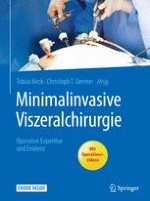Zusammenfassung
Die laparoskopische Versorgung von Nabel- und Narbenhernien nimmt einen besonderen Stellenwert ein. Es ist nicht nur der zeitgemäße Trend von Seiten der Ärzte und Patienten, Minimalinvasivität zu fördern und zu fordern, für viele Patienten bedeutet der laparoskopische Eingriff eine entscheidende Reduzierung der Morbidität des Eingriffes. In diesem Kapitel nimmt daher neben der Darstellung der Operationstechnik auch die Patientenaufklärung bedeutenden Raum ein. Die abschließende Zusammenfassung der aktuellen Evidenz bietet dem Chirurgen einen Überblick über die wesentlichen Aspekte der laparoskopischen IPOM (intraperitoneale Onlay-Mesh)-Versorgung.











